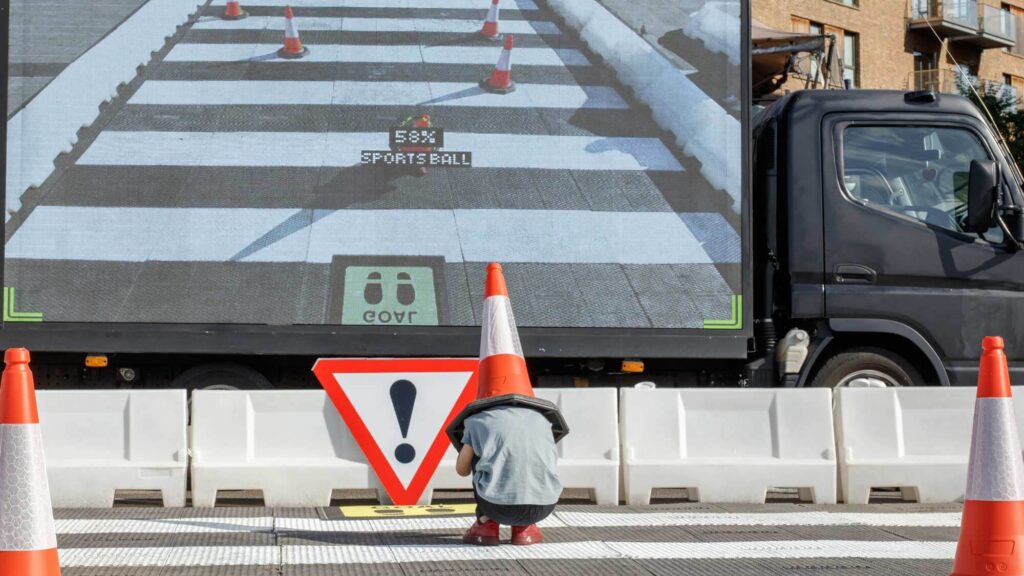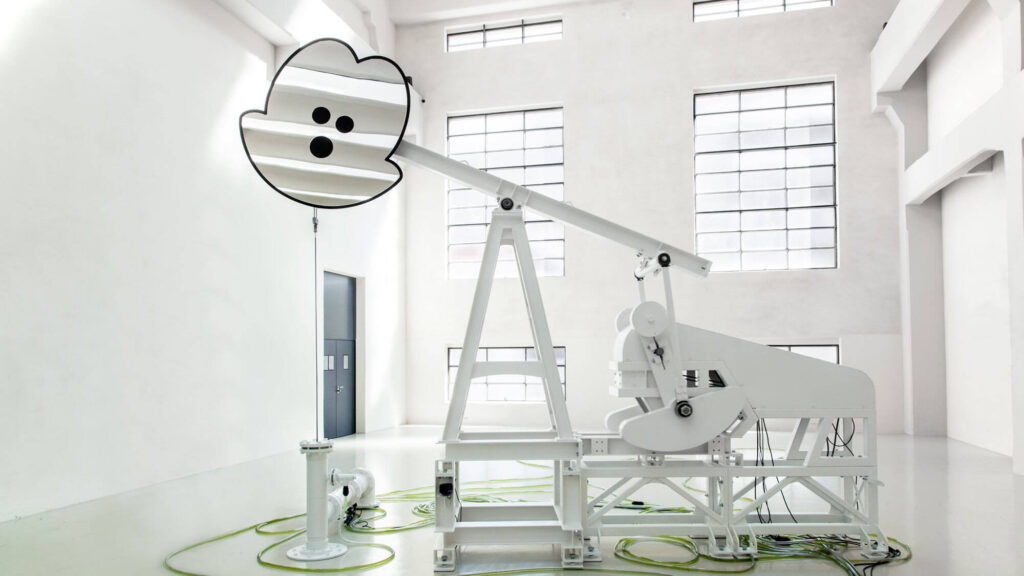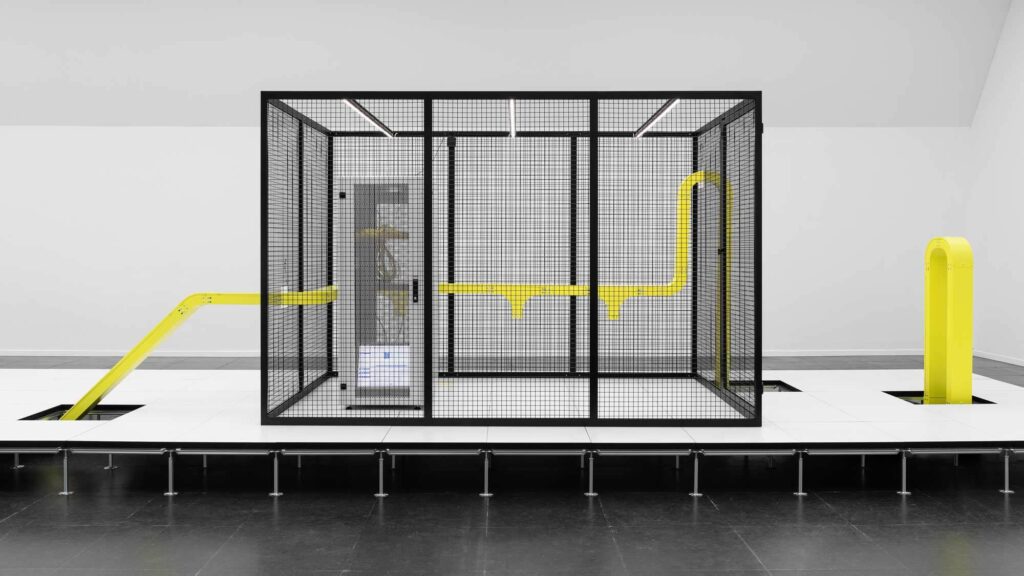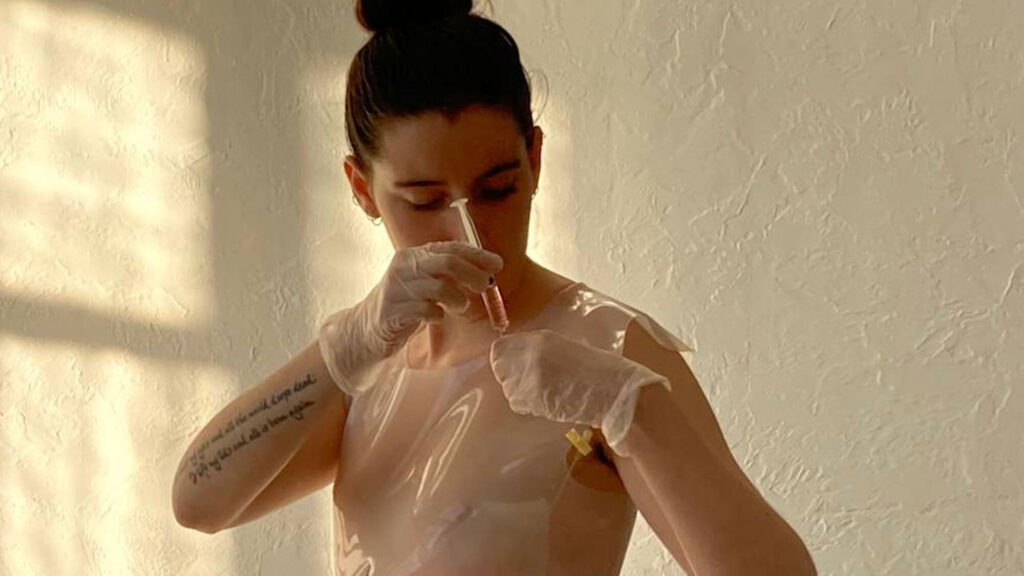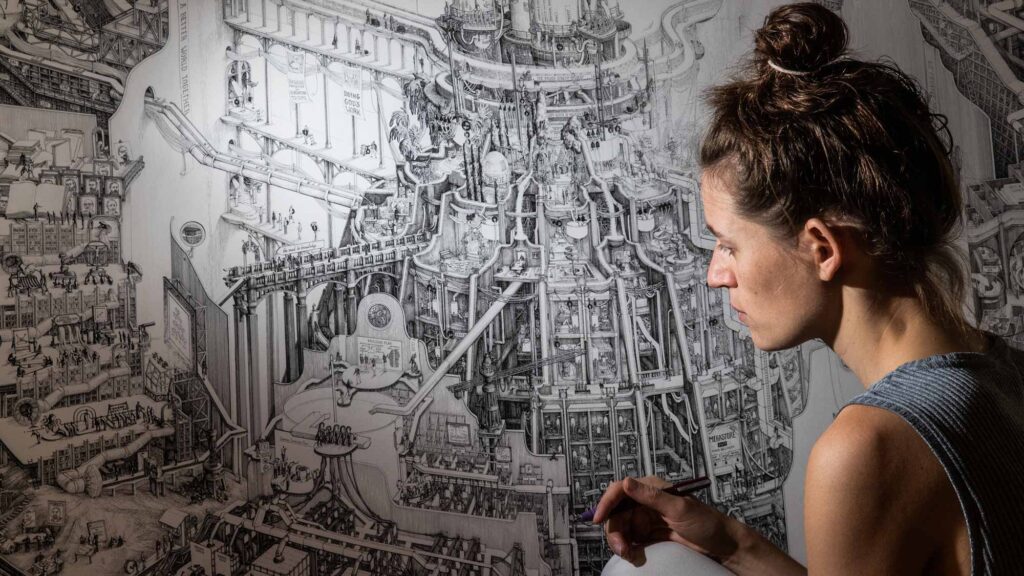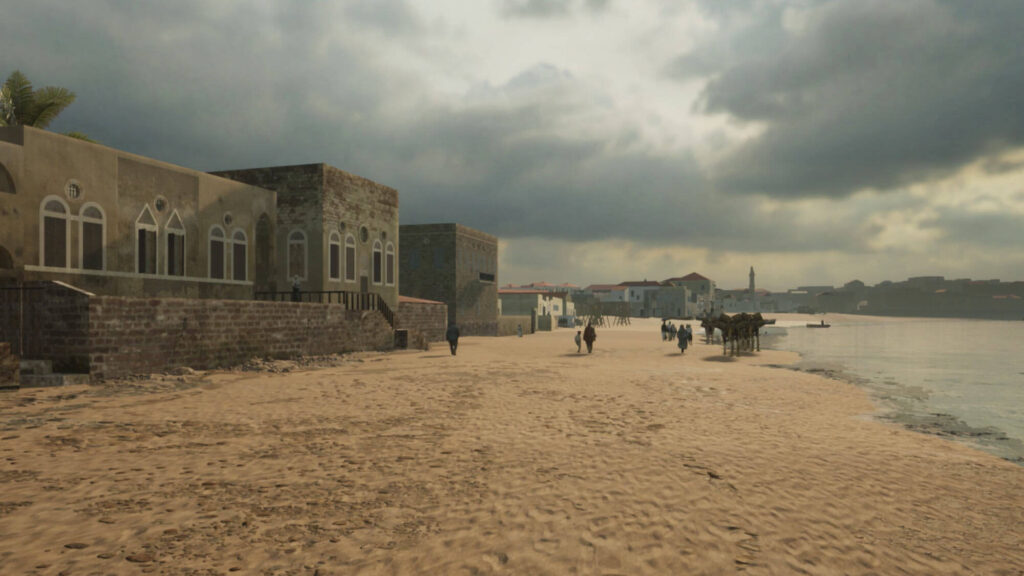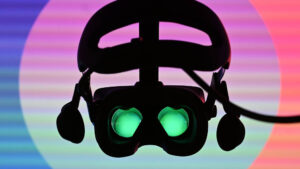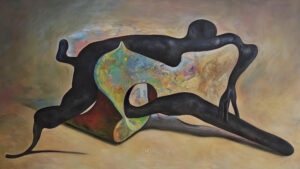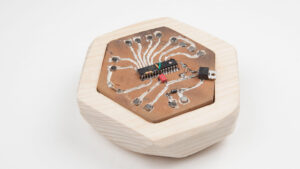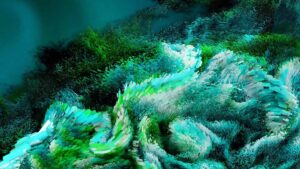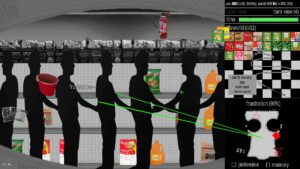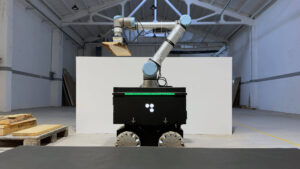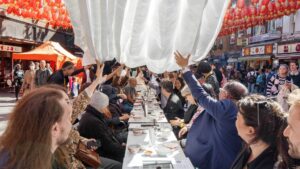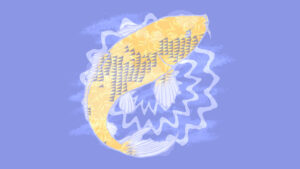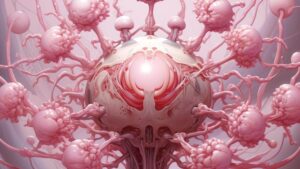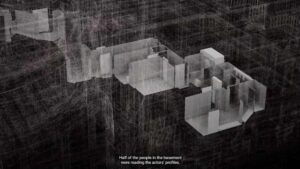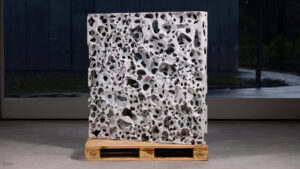2024 Winners – S+T+ARTS Prize (original) (raw)
These are the winners of the S+T+ARTS Prize – Grand prize of the European Commission honoring Innovation in Technology, Industry and Society stimulated by the Arts:
How (not) to get hit by a self-driving car
Tomo Kihara (JP), Daniel Coppen (GB)
How (not) to get hit by a self-driving car is a game installation that challenges people to cross the street without being detected by an AI. In the experience, players see themselves augmented on a large screen at the end of a playing field, simulating the perspective of an AI-powered camera of a self-driving car.…
Korallysis
Gilberto Esparza (MX)
Korallysis is a hybrid organism made up of technological devices and coral colonies that coexist in a mutualistic relationship. It is formed from ceramic segments, based on a geometry that allows it to adapt to the seabed. Its structure creates an ideal habitat for the development of coral communities, as a refuge for fish in…
Mapping Uncertain Landscape: The Satellite
Sofia Isupova (UA)
The project explores the relationship between humans and machines, the map maker, and the map, looking closely at the remote-sensing infrastructures, and their problematics as well as questioning maps and mapping processes to detect changes in the landscape that are occurring daily due to the ongoing Russian war in Ukraine. Transforming satellite images into maps…
Maria CHOIR
Maria Arnal Dimas (ES)
Maria CHOIR is an immersive human-AI musical installation that invites participants to explore the boundaries of singing and listening through real-time interaction with an AI. This artwork leverages a model trained on the voice of singer Maria Arnal, enabling a unique duet between visitor and AI that evolves with each interaction, becoming a choir.
METABOLICA
Thomas Feuerstein (AT)
METABOLICA opens up the factory of life and in five chapters tells a story of change from the industrial revolution to the present and future, from whaling and petromodernity to current and future scenarios of biochemistry. Living organisms such as algae and bacteria become collaborators that lead to a new aesthetic and artistic practice through…
P2P
Eva & Franco Mattes (IT, US)
Inspired by a speculative project by architect Rem Koolhaas—who planned to bring a museum inside a data center—but reversing it by bringing a data center inside a museum, P2P celebrates peer communities created by artists who have used the internet to share works and knowledge over the last twenty years.
Self-Care
Lyndsey Walsh (US)
Self-Care is a multi-media artwork and installation exploring notions of care, labor, intergenerational trauma, and bodies, as well as the impact of the gender binary on so-called “female” healthcare. Self-Care aims to critically examine notions of care, the role of gender in medicine, ableism, and familial relationships surrounding notions of disease. The project attempts to…
The Echinoidea Future – Adriatic Sensing
Robertina Šebjanič (SI)
Echinoidea Future – Adriatic Sensing explores the biogeological and morphological conditions impacting the sea urchin habitat. Anthropogenic liquid waste threatens their environment, leading to low oxygen levels in seawater. The study focuses on dissolved oxygen flux in coastal areas, revealing pollution’s profound impact on biodiversity. The ongoing dialogue prompts reflection on oceanic changes, transcending ecological…
The Waterworks of Money
Carlijn Kingma (NL)
Although money plays a key role in our lives, the workings of our monetary and financial system are a mystery to most of us. The Waterworks of Money demystifies the world of big finance by visualizing the flow of money through our society. It explores several options for improvement using new technologies—with the ultimate goal…
VRJ Palestine
Nisreen Zahda (PS)
The VRJ Palestine initiative (Virtual Reality Journey to pre-Nakba Palestine) delves into the potential and challenges of Virtual Reality tools to reclaim and recapture Nakba’s lost landscapes. Using archival data and survivors’ accounts to virtually reconstruct the Palestinian villages demolished in 1948, it aims to preserve intergenerational memories conveyed through stories and photos.
AUTOPOIESIS
ATELIER-E (DE)
How might an installation engage not with humans directly, but with their minds? AUTOPOIESIS offers an experience that defies easy interpretation, oscillating between activation and deceleration. It utilizes our sensory system, converting light and sound into neurophysiological processes, exploring how audio-visual stimuli affect the brain.
Bibliokepos
Nomad Garden (ES)
Libraries are democratic places, open to everybody, and as the inscription at the entrance to Epicurus’ Garden Kêpos stated: “Stranger, your time will be pleasant here”. Bibliokepos aspires to rethink the public libraries in Seville as facilities in a climate emergency scenario. The project explores the future of existing libraries as shelters, imagining them as…
Botto
Botto Project (The internet)
Botto is a new kind of art form: a decentralized autonomous artist existing at the intersection of machine creativity and decentralized social coordination. Each week Botto creates thousands of prompts and images employing machine learning algorithms to generate captivating digital artworks, all unedited by humans.
Clay PCB
Patrícia J. Reis (PT/AT), Stefanie Wuschitz (AT)
It is an open secret that the hardware in our smart devices contains not only plastics but also ‘conflict minerals’ such as copper and gold. Technology is not neutral. We investigate alternative hardware from locally sourced materials from a feminist perspective, to develop and speculate upon renewable practices.
Destination Earth
Salomé Bazin (FR)
Destination Earth is a multi-sensory installation revealing the connection that ties atmosphere and ocean, humans and inhabitants of the sea, into a flow of interconnected motions. Warming waters and changes in the overall water circulation are impacting sound propagation in the ocean, sea mammal migratory patterns and survival, influencing in return our climate and the…
FORMATA
PЯОТO-ALIEИ PЯOJECT (JP)
FORMATA is a multi-sensory art installation, featuring lively and autonomous blobs within an experimental reactor crafted to simulate the conditions of an alien world with liquid formamide. The vibrant blobs that inhabit this ‘mini-planet’ are composed of abiotic fatty acids, amino acids, and hydrocarbons—echoing the organic materials found in meteorites and comets.
Godmode Epochs
dmstfctn (UK)
Godmode Epochs is a single and multiplayer AI training clicker game set among the lined shelves of an infinite, simulated supermarket. Each playthrough is a numbered “training epoch” during which players race against time to teach an AI to identify products. As players inevitably frustrate the AI, they are taken into its mind—a dungeon filled…
GR-AI-N
Marielena Papandreou (GR)
The GR-AI-N project seeks to harness the potential of discarded materials from the wood industry. This involves a type of digital craft that is grounded on computer vision and robotics. Post-scanning, AI-powered tools are employed to extract wood’s grain patterns, texture, imperfections. This data is used to enable unique designs that harmonize with the natural…
Low Carbon Chinatown
Ling Tan (SG/UK)
Low Carbon Chinatown (LCC) is an interactive urban intervention, participatory platform, and meal-as-performance, founded on AI and data science, addressing the Climate Crisis through the lens of global agri-food systems. Using Asian Chinese diasporic food culture as a starting point, it engages large groups of cross-generational diasporic East and Southeast Asians (ESEA) in the UK…
Narrative Futures: Panchatantra Fables meet Personal Primer
Daniel Devatman Hromada (SK), DigiEduBerlin (M)
The concept of human-machine peer learning (HMPL), where a human learns from the machine (e.g. reading, foreign language) at the same time as the machine learns from the human (e.g. speech recognition), is deployed in the book-like artefact ready to narrate wisdom of ancient India.
Nishikigoi NFT
Toshi (JP)
Nishikigoi NFT is a project that supports diverse cultures by connecting art and technology with local communities. We work to create a new type of community that uses blockchain technology to preserve the vital local resources that we need to live.
Prometheus Firebringer
Annie Dorsen (US)
Prometheus Firebringer is a lecture-performance about generative AI, technology and power. On the performance side, the predictive text model GPT-4 generates speculative versions of the lost final play of Aeschylus’ Prometheia trilogy. Each night, a chorus of AI-generated Greek masks performs a new iteration. On the lecture side, Dorsen delivers a talk made up entirely…
Revolution Refridge
Rojava Center for Democratic Technologies (SY), Dani Ploeger (NL)
‘European-style’ refrigerators can only be operated with a large solar system that costs the equivalent of a year’s income or more. Especially during the extreme summer heat, the absence of adequate cooling systems has detrimental effects on the quality of life. At the same time, many people are not keen to explore alternatives that are…
Sentient Clit: the Pussification of BioTech
Jiabao Li (CN), WhiteFeather Hunter (CA)
We investigate the potential of producing lab-grown clitorises by isolating stem cells from menstrual fluid and 3D-bioprinting them into anatomically accurate gel supports (clits) for in vitro growth. We have differentiated the cells into neuronal types to speculate creating clitorises that respond ‘intelligently’ to stimuli through cultured neural networks.
Soft Collision
Anna Schaeffner (FR)
Soft Collision (2024) looks at the potential of safe physical interaction by embracing collision rather than avoiding it. Through a deformable, pneumatic membrane that serves as a tangible interface to foster direct manipulation and live programming, making interactions more intuitive and inclusive.
Solar Protocol
Solar Protocol Collective led by Tega Brain, Alex Nathanson, and Benedetta Piantella (M)
Solar Protocol is a planetary-scale network of solar-powered servers, installed and maintained by volunteers around the world. The servers collectively host the Solar Protocol web platform at http://solarprotocol.net/, serving it from whichever server is in the most sunshine and therefore generating the most energy, at the time.
The Russian Airstrike on the Mariupol Drama Theater
The Center for Spatial Technologies
The destruction and subsequent occupation of Mariupol by the Russian Armed Forces have fragmented its communities, leaving most survivors dispersed across different regions of Ukraine and other parts of Europe, and the city beyond reconstruction. This project looks at the bombing of the Mariupol Drama Theater as an emblem of Russia’s strategies of terror. Our…
The Urban Biotope
Vasily Sitnikov (RU)
The Urban Biotope project operates on the borderline between human and non-human habitats. The 15 cm thick concrete screens for the building envelope create an interconnected cellular space for various biological species, surrounding the building with a self-sufficient ecosystem. Carefully sized cavities provide a favorable environment for various species of plants, insects, and nesting birds.
